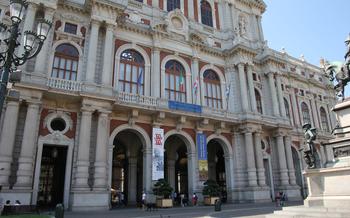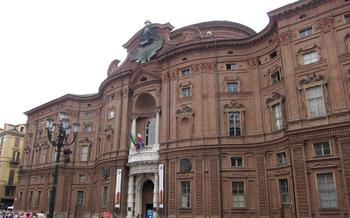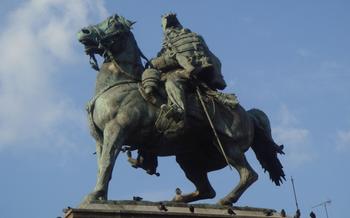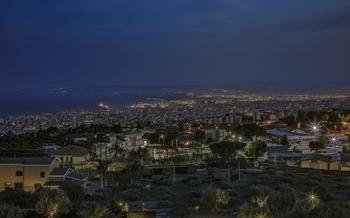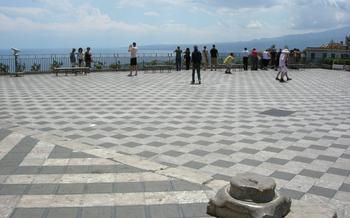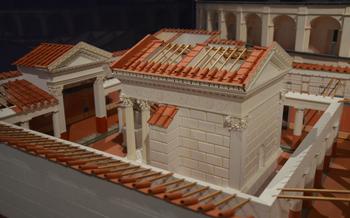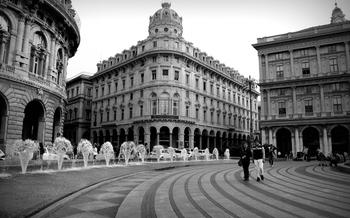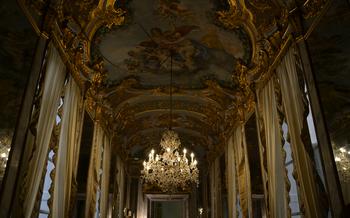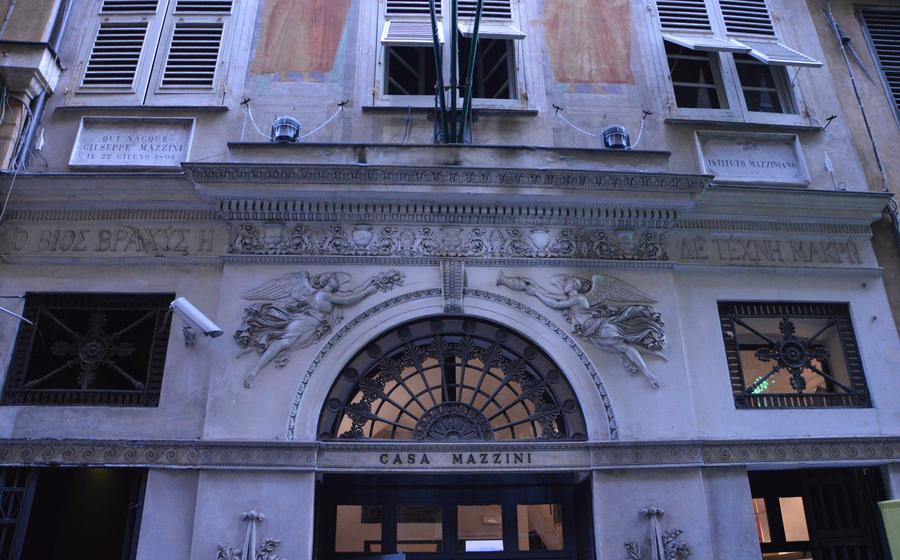
Museo del Risorgimento
- Historical Background and Overview
- Location and Transportation
- Museum Hours and Admission
- Permanent Collections
- Temporary Exhibitions
- Genoa's Role in the Risorgimento
- Garibaldi and the Red Shirts
- The Battle of Mentana
- The Legacy of the Risorgimento
- Interactive Exhibits and Activities
- Guided Tours
- Accessibility
- Gift Shop and Bookstore
- Food and Drink Options
- Insider Tip
Historical Background and Overview
The Italian city of Genoa, known for its bustling port and rich maritime history, played a pivotal role during the Risorgimento, the 19th-century movement that unified Italy into a single nation-state. The Risorgimento, meaning "resurgence" or "revival," was a period of intense political and social upheaval, marked by revolutions, wars, and diplomatic maneuvers, all aimed at achieving Italian unification.
The Museo del Risorgimento in Genoa stands as a testament to this transformative era. Housed in the magnificent Palazzo Bianco, a 16th-century palace in the heart of the city, the museum offers visitors a comprehensive exploration of the Risorgimento through its collection of artifacts, documents, and multimedia displays.
Location and Transportation
The Museo del Risorgimento is conveniently situated in the heart of Genoa, at Via Lomellini 11, just a short walk from the Principe train station and the De Ferrari metro station. Visitors can easily reach the museum by public transportation, making it an accessible attraction for those exploring the city. Additionally, the museum is wheelchair accessible, ensuring that visitors with disabilities can fully enjoy their visit.
Museum Hours and Admission
The Museo del Risorgimento in Genoa is open to the public from Tuesday to Sunday. It observes the following opening hours:
- Tuesday to Saturday: 9:00 AM - 5:00 PM
- Sunday: 1:00 PM - 5:00 PM
The museum is usually closed on Mondays, except during public holidays. It is advisable to check the museum's website or contact them directly for any updates or changes to their operating hours, especially during national holidays or special events.
Admission fees to the museum vary depending on the type of ticket and any applicable discounts. The general admission fee for adults is typically around €00. Reduced admission fees may be available for students, seniors, and other visitors who qualify for concessions. The museum also offers family tickets and group discounts for organized tours.
Guided tours of the museum are available in Italian and English. The cost of a guided tour is usually included in the admission fee, but it is recommended to book a tour in advance to ensure availability. Visitors can book guided tours directly at the museum's front desk or through the museum's website.
Permanent Collections
The Museo del Risorgimento houses a vast and diverse permanent collection that takes visitors on a journey through Italy's struggle for unification. At the heart of the collection are personal items and artifacts that belonged to key figures of the Risorgimento, including Giuseppe Garibaldi, Camillo Benso, Conte di Cavour, and Giuseppe Mazzini. Their uniforms, weapons, and personal belongings offer a tangible connection to these historical figures and their unwavering dedication to the cause of Italian unity.
The museum also showcases a rich array of documents, letters, and proclamations that chronicle the events and decisions that shaped the course of the Risorgimento. These include original manuscripts of speeches and manifestos, as well as newspaper articles and pamphlets that captured the spirit and fervor of the movement. Through these documents, visitors can trace the evolution of the Risorgimento from its early stirrings to its eventual triumph.
In addition to these personal and historical artifacts, the museum features a collection of paintings, sculptures, and engravings that depict scenes from the Risorgimento. These works of art bring to life the struggles and triumphs of the movement, offering a visual representation of the sacrifices and heroism that led to Italy's unification.
Interactive multimedia exhibits enhance the visitor experience, providing deeper insights into the events and people of the Risorgimento. These exhibits utilize touchscreens, audio-visual displays, and interactive maps to engage visitors and bring the past to life.
Temporary Exhibitions
In addition to its permanent collection, the Museo del Risorgimento often hosts temporary exhibitions that explore various aspects of the Risorgimento and its impact on Italy. These exhibitions may focus on specific historical events, notable figures, or artistic and cultural movements that were influenced by the Risorgimento. Visitors can expect to see a diverse range of artifacts, documents, and artworks that shed light on the complexities and significance of this period in Italian history.
Temporary exhibitions at the Museo del Risorgimento are typically accompanied by educational programs, lectures, and guided tours that provide visitors with a deeper understanding of the themes and topics being explored. These exhibitions offer a unique opportunity to learn about lesser-known aspects of the Risorgimento and to engage with contemporary perspectives on this transformative period in Italy's history.
Genoa's Role in the Risorgimento
Genoa played a significant role in the Risorgimento movement, contributing both financially and militarily to the cause of Italian unification. The city was a hotbed of revolutionary activity, with many of its citizens actively involved in the fight against Austrian rule. Notable figures from Genoa who played a prominent role in the movement include Giuseppe Mazzini, one of the founders of the Young Italy movement, and Nino Bixio, a close associate of Giuseppe Garibaldi.
Genoa was also the site of several key events during the Risorgimento. In 1849, the city hosted the first Italian National Assembly, which was attended by representatives from all over the peninsula. The assembly's goal was to establish a unified Italian republic, but it was ultimately unsuccessful due to the intervention of Austrian forces.
In 1860, Garibaldi and his Red Shirts set sail from Genoa on their expedition to conquer the Kingdom of the Two Sicilies. This expedition was a major turning point in the Risorgimento, as it led to the unification of much of southern Italy under the rule of the Kingdom of Sardinia.
Garibaldi and the Red Shirts
In the chronicles of the Risorgimento, one name stands out above all others: Giuseppe Garibaldi. A charismatic and daring military leader, Garibaldi became a symbol of the Italian struggle for unification. Along with his loyal band of Red Shirts, Garibaldi led a series of audacious campaigns that played a pivotal role in the unification of Italy.
The Red Shirts, so named for their distinctive attire, were a volunteer army of Italian patriots and international revolutionaries who fought alongside Garibaldi. United by a shared passion for Italian independence, they hailed from diverse backgrounds and walks of life. Among them were students, farmers, and even former criminals, all drawn to Garibaldi's charismatic leadership and unwavering belief in Italy's destiny.
Garibaldi's military campaigns were characterized by their audaciousness and tactical brilliance. In 1860, he launched his famous Expedition of the Thousand, sailing from Genoa with a small force of Red Shirts to liberate Sicily from Bourbon rule. The expedition was a resounding success, and Garibaldi quickly gained control of the island. He then crossed over to the mainland and marched north, conquering Naples and eventually entering Rome in 186
Garibaldi's victories paved the way for the unification of Italy under the rule of King Victor Emmanuel II. However, his relationship with the monarchy was complex and often strained. Garibaldi was a republican and believed that Italy should be a republic, not a monarchy. Nevertheless, he recognized the importance of unity and eventually agreed to support the monarchy as a way to achieve his ultimate goal of a unified Italy.
The Battle of Mentana
In November 1867, the Battle of Mentana took place near Rome involving Giuseppe Garibaldi's Red Shirts and the Papal Zouaves, a military unit protecting the Papal States. The battle, which aimed to capture Rome and complete the unification of Italy, ended in the defeat of Garibaldi's forces. Despite their defeat, the Battle of Mentana had a profound impact on the Risorgimento. It highlighted the international dimension of the Italian unification struggle and drew attention to the role of foreign powers, particularly France, in supporting the Papal States. The battle also contributed to the growing tensions between Italy and France, which would eventually lead to the Franco-Prussian War in 1870.
The Legacy of the Risorgimento
The Risorgimento had a profound and lasting impact on Italy, shaping its political, cultural, and social landscape. The movement led to the unification of the Italian peninsula, creating a sense of national identity and unity that had been lacking for centuries. The Risorgimento also spurred a period of cultural and intellectual rebirth, as artists, writers, and thinkers sought to express the new spirit of the nation.
But the legacy of the Risorgimento is still debated today. Some historians argue that the movement succeeded in creating a unified and independent Italy, while others contend that it led to the creation of a centralized state that suppressed regional and cultural identities. The Risorgimento also led to the creation of a myth of national unity that has been used to justify various political ideologies and actions, both positive and negative.
Despite these debates, the Risorgimento remains a pivotal event in Italian history, and its legacy continues to shape the country's identity and culture. The Museo del Risorgimento in Genoa offers visitors a chance to learn more about this complex and fascinating period, and to reflect on its enduring impact on Italy.
Interactive Exhibits and Activities
In addition to its collection of artifacts and documents, the Museo del Risorgimento offers a range of interactive exhibits and activities that enhance the visitor's understanding of the Risorgimento. These exhibits employ cutting-edge technology and multimedia tools to create an immersive and engaging experience for visitors of all ages.
One of the highlights of the museum is its interactive map of Italy, which allows visitors to explore the key events and battles of the Risorgimento in chronological order. Visitors can touch different parts of the map to learn more about specific events and view related images and documents.
Another popular exhibit is the "Voices of the Revolution," which features audio recordings of first-hand accounts from participants in the Risorgimento. Visitors can listen to these recordings and gain a personal perspective on the events of this tumultuous period.
For children, the museum offers a variety of educational games and activities that make learning about the Risorgimento fun and engaging. These activities include puzzles, quizzes, and interactive timelines that help children understand the complex events of the period.
The Museo del Risorgimento's interactive exhibits and activities make it a great destination for families and visitors of all ages who want to learn more about the Risorgimento in a fun and engaging way.
Guided Tours
For a more in-depth and personalized experience, the Museo del Risorgimento offers guided tours in Italian, English, French, and German. Guided tours provide visitors with the opportunity to learn about the museum's collection and the history of the Risorgimento from a knowledgeable and experienced guide. Tours typically last for about an hour and a half and can be booked in advance online or upon arrival at the museum. Prices for guided tours start at €10 for adults and €8 for students and seniors.
Accessibility
The Museo del Risorgimento is committed to ensuring that all visitors, regardless of ability, can enjoy and learn from its exhibits. The museum is wheelchair accessible, with ramps and elevators providing access to all floors. Additionally, the museum offers a variety of accessibility features, including:
-
Audio guides in Italian and English that provide detailed descriptions of the exhibits, including information on their historical significance and relevance to the Risorgimento.
-
Braille labels on many of the exhibits, allowing visually impaired visitors to explore the museum independently.
-
Touchscreens and interactive exhibits that are designed to be accessible to visitors with a range of disabilities.
-
A dedicated staff member who is trained to assist visitors with disabilities.
While the museum has made significant efforts to ensure accessibility, there are a few areas where visitors may encounter challenges. For example, the museum's entrance is located up a short flight of stairs, and there is no elevator access to the museum's terrace. However, the museum staff is happy to assist visitors in overcoming these challenges.
Gift Shop and Bookstore
In the well-stocked gift shop and bookstore of the Museo del Risorgimento, visitors can find an assortment of souvenirs and publications to commemorate their visit and deepen their understanding of the period. From postcards and magnets featuring iconic images of the Risorgimento to books and catalogues exploring the movement's history and key figures, there is something for every visitor. Particularly noteworthy are the museum's exclusive publications, which offer in-depth insights into specific aspects of the Risorgimento and are not available elsewhere.
Food and Drink Options
While the Museo del Risorgimento doesn't have a dedicated cafe or restaurant on its premises, visitors can find a variety of food and drink options nearby. The surrounding area offers a range of cafes, bars, and restaurants, catering to diverse tastes and budgets. From traditional Italian trattorias serving up classic pasta dishes to modern bistros offering innovative culinary creations, there's something for everyone within walking distance of the museum. For a quick bite, visitors can grab a sandwich or pastry from one of the many bakeries or delis in the area. For those looking to indulge in a leisurely meal, there are several restaurants nearby that offer a delightful selection of local and international cuisine. Whether you're looking for a cappuccino and croissant to start your day or a glass of wine to unwind after your museum visit, the neighborhood surrounding the Museo del Risorgimento has something to satisfy your cravings.
Insider Tip
For an optimal experience, plan your visit to the Museo del Risorgimento on a weekday morning, as it tends to be less crowded during this time. Consider combining your visit with a stroll through the picturesque alleys of Genoa's historical center, where you'll discover hidden gems like the Palazzo Ducale and the Piazza de Ferrari. Keep an eye out for special events or exhibitions that the museum may host throughout the year, as these often offer unique insights into the Risorgimento period.
